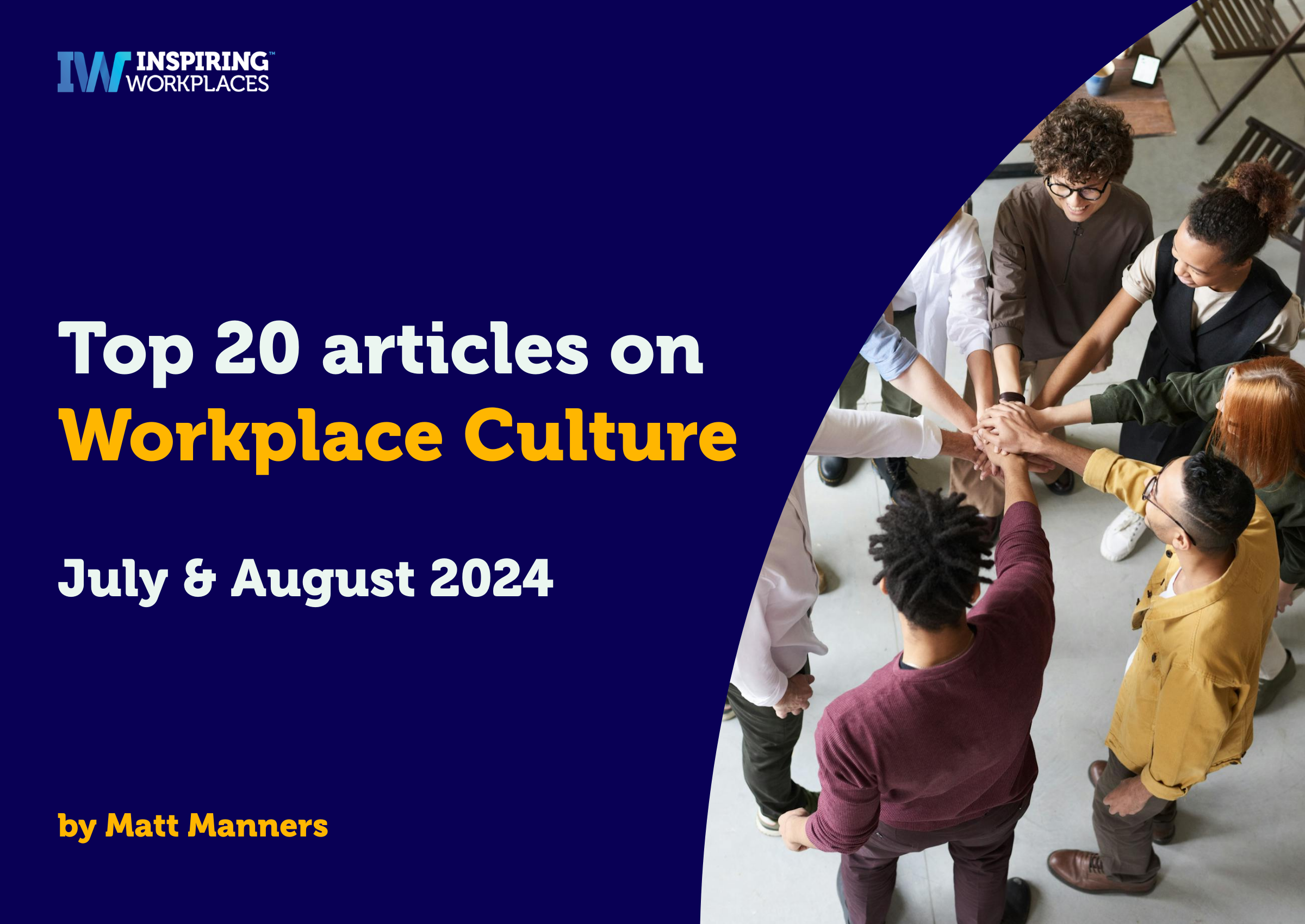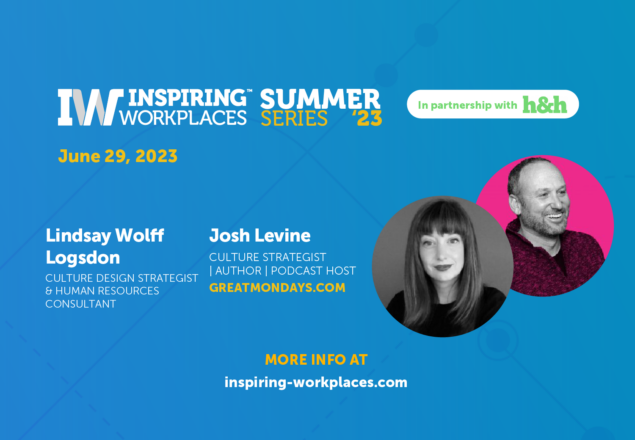
10th September 2024
Top 20 Articles on Workplace Culture: July & August 2024

Welcome to the Inspiring Workplaces Top 20 Articles on Workplace Culture for July & August 2024.
We want to help inform and inspire you from some of the best content out there. Each month we will consolidate these articles for you to help give you a quick and easy snapshot. To help drive you and your organisations forward.
The articles will be underpinned by seven key elements that are reflected in our bespoke COMPASS methodology, that also underpin the Top Inspiring Workplaces worldwide. They are:
- Wellbeing
- Culture & Purpose
- Leadership
- Inclusion
- Employee Experience
- Communication & Voice
- Society & Sustainability
Key Workplace Culture Learnings from July & August:
- Hope and Meaningful Work: Employees with hope and meaningful work are less likely to experience burnout and disengagement.
- Resilience’s Role: Resilience builds a positive work environment, fostering personal growth and better performance.
- Financial Strain: Daily financial stress reduces employee focus and productivity, emphasizing the need for financial wellness programs.
- Inclusion in the Workplace: Employees require support in areas like neurodiversity, fertility, and gender identity, impacting overall well-being.
- Empathetic Leadership: Managers who support employees and show genuine empathy foster trust, reducing stress.
- Collaboration in Policy-Making: Involving employees in decision-making around work policies leads to better engagement and retention.
- Work-Life Flexibility: Benefits like flexible working arrangements are valued more than small salary increases.
- Mental Health Support: Addressing mental health, especially for hybrid workers, is crucial for maintaining productivity and focus.
- Impact of Listening: Active listening enhances performance and employee satisfaction, strengthening relationships within teams.
- Human-Centric Leadership: Focusing on well-being and aligning organizational goals with employee values drives performance and loyalty.
The articles are as follows…
New study discovers surprising remedy that protects workers against career burnout, job stress
Source: Forbes
Author: Bryan Robinson, Ph.D.
IW COMPASS point: Wellbeing
Key Takeaways
- Significance of Meaningful Work: Employees who find their work meaningful experience fewer daily stressors and negative feelings.
- Role of Hope in Employee Well-being: Hope, derived from personal growth, creativity, and impact, leads to greater engagement and investment in work roles, fostering a positive work culture and better retention.
- Resilience as a Key Driver: Resilience, characterized by positivity, self-efficacy, and problem-solving, significantly contributes to a strong sense of hope and overall employee well-being.
- Benefits of Hope: Employees with high levels of hope are less likely to experience burnout, anxiety, and depression and are less likely to engage in “quiet quitting.”
- Impact on Turnover and Belonging: Hope reduces turnover intent by half and significantly lowers risks of burnout, anxiety, and depression when employees feel a strong sense of belonging.
- Importance of Manager Support: Strong manager support leads to higher feelings of respect and value among employees, significantly impacting their well-being.
- Hope as a Coping Mechanism: Hope helps employees persevere through challenges, enhances productivity, creativity, and job satisfaction, and is crucial during organizational changes and uncertainties.
- Sources of Hope: Major sources of hope include family relationships, financial stability, personal growth, friends, hard work, faith, self-improvement, and creativity, with political and social change being the least significant.
- Historical and Philosophical Insights: The study draws parallels to Stoic philosophy and Viktor Frankl’s teachings on choosing one’s attitude in difficult circumstances, highlighting the power of a hopeful mindset.
- Organizational Implications: Cultivating hope within organizations can create a resilient workforce, better equipped to handle stress, overcome obstacles, and find meaning in their work, ultimately enhancing individual and organizational well-being.
Read the full article here
Senior leaders are heading for the door because of office mandates – this is how to stop them
Source: People Management
Author: Caitlin Duffy
IW COMPASS point: Employee Experience
Key Takeaways
- Trend of RTO Mandates:
- Increasing return to office (RTO) mandates are gaining momentum.
- 63% of HR leaders reported increased expectations for office attendance.
- Executive Exodus:
- One in three executives will leave their firm in response to RTO mandates.
- 36% of senior-level jobseekers left due to RTO mandates.
- One third discontinued hiring processes due to expected RTO.
- Challenges for Talent Attraction and Retention:
- Mandating RTO policies poses serious challenges for attracting and retaining talent.
- A balance between onsite, remote, and hybrid practices is crucial.
- Motivate Instead of Mandate:
- Employees need motivation rather than mandates to return to the office.
- Provide clear rationale for onsite work, emphasizing tasks that benefit from being done in-person.
- Ensure transparency about the reasons behind RTO policies to gain employee buy-in.
- Foster an inclusive environment that meets both emotional and physical needs of employees.
- Employee Involvement in Policy Shaping:
- Significant misalignment exists between employees and employers on hybrid work models.
- 77% of digital workers want to help create their hybrid work model.
- Only 40% of employees felt their feedback was considered in RTO mandate designs.
- Establishing a two-way dialogue for feedback and questions is crucial.
- Benefits of Collaborative Policy Making:
- Involving employees in decision-making improves engagement, discretionary effort, and retention.
- Clear communication of onsite policy rationale fosters a more inclusive, human-centric environment.
- Strategies for Reducing Attrition:
- Open communication and trust building can mitigate attrition risks.
- Enabling employees to shape their RTO requirements enhances collaboration and engagement.
- Focusing on shared goals and transparent policies can achieve higher satisfaction, performance, and retention.
Read the full article here
Lowering your bar drives productivity and inspires creativity
Source: IW Guest Blog
Author: David Beeney
IW COMPASS point: Wellbeing
Key Takeaways
- Personal Experience with Panic Attacks:
- David Beeney, founder of Breakingthesilence.co.uk, has dealt with panic attacks for over 40 years.
- Accepting the possibility of panic attacks and giving himself permission to experience them has significantly reduced their occurrence.
- The Power of Permission & Lowering the Bar:
- Lowering personal expectations and being kinder to oneself can reduce stress and improve productivity and creativity.
- Self-compassion leads to a more relaxed state of mind, resulting in greater clarity of thought and better work quality.
- Creating a Healthier Work Culture:
- Organizations should adopt a flexible and compassionate approach to expectations to promote employee wellbeing.
- Lowering unrealistic expectations helps reduce stress and anxiety, fostering long-term performance and mental health.
- Continuous improvement and personal growth should be prioritized over unattainable perfection.
- Long-Term Value:
- Focusing on long-term performance rather than short-term high expectations prevents employee burnout.
- Setting realistic goals considering employees’ needs enhances resilience and adaptability within the workforce.
- Beeney’s book “Breaking The Silence,” shares his journey and provides guidance on prioritizing mental health and creating kinder workplace cultures.
- Leaders are encouraged to play a crucial role in fostering supportive environments for mental health.
Read the full article here
5 ways to improve your listening skills
Source: IW Guest Blog
Author: Harvey Deutschendorf
IW COMPASS point: Communication
Key Takeaways
- Listening is as important as speaking: Despite the focus on public speaking, listening is vital for trust and loyalty.
- Be fully in the moment: Ensure complete attention when someone speaks by observing tone, body language, and emotions.
- Put yourself in their shoes: Understand their perspective by empathizing with their situation and struggles.
- Acknowledge key points: Show you’re listening by highlighting key points and asking for clarification when needed.
- Practice active listening: Focus entirely on the speaker without preparing your response, and give feedback based on what you’ve heard.
- Develop curiosity and openness: Stay open to learning from conversations, seeking continuous growth and new perspectives.
Read the full article here
The recruitment process is more digital than ever
Source: Gallup
Author: Andy Kemp
IW COMPASS point: Employee Experience
Key Takeaways
- Stable Talent Pipeline: Maintaining a stable talent pipeline is crucial for organizational success amid elevated U.S. job opening rates.
- Hiring Projections: 39% of Fortune 500 CHROs expect to expand their workforce in 2024.
- Recruitment Trends: Technological advancements and the COVID-19 pandemic have significantly altered the recruiting landscape.
- Recent Recruitment Statistics: 24% of U.S. employees have been recruited by another organization in the past three months, up from 19% in 2015.
- Poaching Employees: Recruiters increasingly target employees from other organizations who aren’t actively job hunting, with a 19% chance of being recruited within three months.
- Digital Recruitment Dominance: Online recruiting, particularly through professional networking sites like LinkedIn, has become more effective than traditional methods.
- Increased Online Presence: 50% of recently recruited employees were found through online sites, up from 39% in 2015.
- Employee Movement: Employees recruited through online networking sites and job search firms are more likely to leave their current jobs.
- Effectiveness of Digital Methods: Digital recruitment methods are more effective than traditional channels such as word of mouth and professional communities.
- Importance of Digital Presence: A strong digital presence is crucial to attract passive job seekers transitioning to active job seekers.
- Accurate Job Descriptions: Clear, detailed job descriptions significantly influence applicants’ decisions to apply (59%) more than organizational mission, culture, or online reviews.
- Role Alignment: Accurate job descriptions help candidates assess their alignment with the role, saving time and resources.
- Competitive Edge: Organizations must maintain a strong online presence and provide detailed job descriptions to stay competitive in the digital recruitment space.
Read the full article here
Building a purpose-led and values-driven culture to retain talent
Source: InTheBlack
Author: Susan Muldowney
IW COMPASS point: Leadership
Key Takeaways
- High-performing teams are not built overnight: They require careful strategies and a supportive culture.
- Employee support and value are key: Teams thrive when members feel supported, valued, and cared for.
- Collaboration and commitment are essential: High-performing teams have clear goals, shared values, and ongoing learning.
- Define and communicate high-performance goals: Leaders must ensure team members know what success looks like.
- Psychological safety matters: Teams perform better when members feel safe to speak up and challenge ideas.
- Measure performance with a holistic approach: Focus on achieving, developing, enjoying, and partnering as a team.
- Learning and development are critical: High-performing teams continually evolve through opportunities for growth.
Read the full article here
Equity is the antidote to talent scarcity: 4 key ingredients to make equity a business success
Source: Forbes
Author: Sander van ‘t Noordende
IW COMPASS point: Inclusion
Key Takeaways
- Talent scarcity requires innovative solutions: Ingraining equity into business practices is a strategic approach to address global labor shortages.
- Equity broadens the talent pool: Equitable practices attract diverse talent, including underrepresented groups, enhancing innovation and market reputation.
- Diverse teams boost performance: Companies with diverse teams are 35% more likely to outperform competitors and experience 22% lower turnover rates.
- Employee alignment with values is crucial: 38% of employees would reject a job offer if the company’s values, especially on equity, don’t align with their own.
- Flexible work arrangements attract diversity: Flexibility in work schedules and locations is particularly important for attracting older workers and retaining a diverse workforce.
- Transparent pay policies build trust: Ensuring equitable pay and transparency is vital for attracting diverse talent and maintaining organizational trust.
- Inclusive hiring practices are essential: Leveraging technology like AI in recruitment can reduce biases and create fairer, more efficient hiring processes.
- Business Resource Groups (BRGs) as advisors: Empowering BRGs helps develop inclusive, equitable workplaces by providing valuable insights and driving the ED&I agenda.
Read the full article here
On purpose? Finding purpose at work and the role of L&D
Source: Training Zone
Author: Jackie Clifford
IW COMPASS point: Culture & Purpose
Key Takeaways
- Purpose-Driven Work: Most Gen Z and Millennial employees desire work that aligns with their personal values and sense of purpose, making it crucial for organizations to align their purpose with that of their employees.
- Role of L&D: Learning and Development (L&D) professionals play a key role in helping organizations ensure that their mission, values, and objectives are clearly communicated and aligned with employees’ work.
- Supporting Purpose Discovery: L&D can assist employees in discovering their purpose through activities like personality profiling, coaching, mentoring, values workshops, and sharing case studies.
- Recruitment Alignment: Attracting purpose-aligned candidates is vital for organizational success, and L&D can support recruitment efforts by ensuring brand messages and recruitment advertising reflect the organization’s purpose.
- Business Benefits: Organizations that support employees in finding their purpose see benefits like increased engagement, improved retention, better job performance, stronger loyalty, and a more positive workplace culture.
- Avoiding Pitfalls: Failing to support personal development can lead to disengagement, poor performance, and high turnover, particularly among Gen Z and Millennial employees.
- Integrated Approach: Efforts to align purpose with work should not be isolated; they need to be part of a broader, strategic approach that also considers financial incentives and organizational goals.
Read the full article here
Outcomes over outputs: Why productivity is no longer the metric that matters most
Source: Deloitte Insights Magazine
Author: Sue Cantrell & Corrie Commisso
IW COMPASS point: Employee Experience
Key Takeaways
- Shift from Productivity to Outcomes: Traditional productivity metrics, focused on outputs, are no longer sufficient in the modern workplace. Organizations need to prioritize human-centric outcomes.
- Challenges with Traditional Productivity Metrics: Metrics like hours worked and revenue per employee are outdated, especially in a technologically advanced and human-centric work environment.
- Productivity Tracking Issues: Excessive tracking of employee activities can lead to “”productivity paranoia”” and performative work, rather than true productivity.
- Exclusion of Workforce Ecosystems: Traditional productivity metrics often fail to account for the contributions of external workers, such as freelancers and contractors, who are increasingly integral to organizations.
- Knowledge and “Invisible” Work: As work becomes more knowledge-based, traditional metrics fail to capture the complexity and value of problem-solving and creative tasks.
- Human Outcomes over Productivity: Shifting the focus to business and human outcomes, such as employee well-being and innovation, can lead to more meaningful organizational success.
- Importance of Human-Centric Metrics: Organizations that measure human outcomes, such as employee happiness and well-being, may see significant improvements in overall performance and productivity.
- Innovative Approaches: Examples like Hitachi’s use of wearables to improve employee happiness demonstrate the potential for human outcome metrics to drive organizational success.
- Future Focus: Organizations that move beyond outdated productivity metrics and embrace a more inclusive, human-centered approach could discover new opportunities for growth and innovation.
Read the full article here
Hybrid workers increasingly reporting negative impact on mental health
Source: HR Director
Author: Tom Nash
IW COMPASS point: Wellbeing
Key Takeaways
- Hybrid workers struggle the most with mental health: 42% report negative impacts on mental wellbeing, compared to 32% of fully remote and 30% of office-based workers.
- Challenges unique to hybrid work: Hybrid employees face difficulties in balancing home and office routines, leading to mental and physical health issues.
- Exercise and fatigue: 41% of hybrid workers skip exercise due to work fatigue, compared to 29% of remote and 31% of office-based workers.
- Longer hours impact hybrid workers more: 26% of hybrid employees skip workouts due to extended work hours, versus 18% of remote workers.
- Burnout and focus issues: Less than half (47%) of hybrid workers report good energy levels, and 36% struggle with focus and concentration.
- Tailored support is essential: Hybrid workers need specific benefits and resources to manage their mental and physical health effectively.
- Generational disparities: Only 15% of Baby Boomers receive mental health benefits, compared to 31% of Gen Z employees.
- Mental health conversations: 37% of Gen Z feel more comfortable discussing mental health at work, while only 20% of Baby Boomers feel the same.
- Wellbeing perceptions: 54% of Gen Z workers believe their employer’s focus on wellbeing contributes to a positive environment, compared to only 24% of Baby Boomers.
- Call for change: Employers must create an inclusive, comprehensive mental health support system that addresses the needs of all generations and work arrangements.
Read the full article here
The DEI illusion: Why diversity without belonging is a recipe for disaster
Source: Campaign
Author: Rafael P. Soriano
IW COMPASS point: Inclusion
Key Takeaways
- Inclusion vs. Belonging: Inclusion often focuses on fitting in, which differs significantly from a sense of true belonging.
- SHRM’s Shift: SHRM’s decision to prioritize inclusion and diversity (I&D) over equity has sparked debate, with some seeing it as clarity and others as neglecting the importance of equity.
- Equity’s Role: Equity is crucial for fostering diversity in the workplace by addressing barriers like geography, education, and social class.
- Post-Hiring Challenge: Bringing a diverse group together is not enough; ensuring they work well together is essential.
- Ambiguity of Terms: SHRM’s removal of “”equity”” and unclear definition of “”inclusion”” highlight the need for clear terminology.
- Personal Experience: The author shares experiences of being included but not truly belonging, emphasizing the need for genuine integration.
- Need for Belonging: Organizations often have diversity policies but lack frameworks for fostering belonging, leading to poor teamwork and low productivity.
- Social-Emotional Learning (SEL): Implementing SEL can train teams in emotional maturity and relationship-building, creating true belonging.
- Belonging as a Skill: Belonging can be defined, measured, and developed, leading to high-functioning teams.
- Diversity Criticism: Lack of belonging frameworks can validate diversity critics and make diversity hires feel tokenized.
- Organizational Advantage: Companies can implement belonging skills faster than societal changes, leading to improved performance and innovation.
- Focus on Belonging: Prioritizing belonging helps organizations embrace diversity and equity more effectively.
Read the full article here
Why competent workers become incompetent managers
Source: Fast Company
Author:Tomas Chamorro-Premuzic & Sunny Lee
IW COMPASS point: Leadership
Key Takeaways:
- Managers significantly impact employee experience: Nearly 70% of employee engagement variability is linked to manager behavior, decisions, and personality traits.
- The Peter Principle: Individuals are often promoted until they reach their level of incompetence, highlighting flaws in promotion strategies that focus solely on past performance.
- Incompetent managers are common: Many individuals who excel as employees struggle in managerial roles due to insufficient leadership skills.
- Promotion based on past performance: Relying solely on an employee’s technical skills can result in ineffective managers, leading to frustration and disengagement among their teams.
- Broaden promotion criteria: Organizations should consider leadership potential, including collaboration and people management skills, alongside technical expertise.
- Develop leadership skills: Training programs in strategic thinking, emotional intelligence, and people management can help bridge the skill gap for new managers.
- Offer separate career tracks: Not every high performer needs to become a manager. Organizations should provide opportunities for technical experts to grow without forcing them into management roles.
- Addressing the Peter Principle: Organizations must rethink their promotion and talent development strategies to foster competent leaders and avoid stagnation in career growth.
Read the full article here
17 Team-Building Activities for In-Person, Remote, and Hybrid Teams
Source: Harvard Business Review
Authors: Rebecca Knight
IW COMPASS point: Employee Experience
Key Takeaways
- Intentional team-building is crucial for fostering connections, especially in remote and hybrid environments.
- Structured conversations and exercises, such as the reflected-best-self, help employees understand each other’s strengths and build strong bonds.
- Conversation cards and casual chats create a low-stakes environment, promoting inclusivity and psychological safety.
- Leverage virtual tools for lighthearted communication and engagement, mimicking in-person interactions in remote settings.
- Tailor team-building activities to fit team size, location, and needs, whether in-person, remote, or hybrid.
- In-person activities like lunches, community service projects, and off-sites strengthen bonds through shared experiences.
- Hybrid teams need careful planning to ensure both remote and in-person members feel included.
- Create rituals and share personal stories to foster a sense of belonging within teams.
- Regular pulse checks help gauge team morale and trust, allowing leaders to take timely actions.
- Manager enthusiasm sets the tone for the success of team-building activities.
Read the full article here
How to build a motivational workplace culture
Source: People Management
Author: Grace French
IW COMPASS point: Culture & Purpose
Key Takeaways
- Recognition drives motivation: 69% of recognized employees work harder, but 40% feel underappreciated. Co-create recognition programs that resonate with employees.
- Clarity and transparency boost trust: 92% say leadership trust is crucial, yet only 40% know company goals. Regularly communicate goals to increase motivation by 55%.
- Effective management is key: Managers impact up to 70% of job satisfaction. Provide ongoing management training and personalized feedback.
- Listening enhances performance: Employees are 4.6 times more likely to perform at their best when they feel heard. Foster open communication channels.
- Avoid boredom by shaking things up: One-third of employees leave due to boredom. Encourage creativity and autonomy to keep employees engaged.
- Well-being empowerment is essential: 32% of UK workers have low stress resilience. Establish mental health support and share personal well-being practices.
Read the full article here
Engagement essentials: Addressing the three biggest mistakes organizations make
Source: IW guest blog
Author: Dr. Dieter Veldsman
IW COMPASS point: Employee Experience
Key Takeaways
- Employee engagement and well-being levels have declined in the U.S. due to external factors like political divides and economic hardships, but internal organizational issues also play a significant role.
- Mistake 1: Treating employee engagement as a metric, not a strategy
- Engagement should inspire action, guide focus, and involve co-creation with employees, not just serve as a performance metric.
- Mistake 2: Using outdated employee listening methods
- Relying solely on annual surveys is ineffective. Organizations need a comprehensive listening strategy that collects continuous feedback across different levels.
- Mistake 3: Stalling in inaction instead of prioritizing incremental changes
- Overwhelm from engagement data can lead to inaction. Prioritizing small, meaningful changes over time drives engagement improvements.
- Adopting a holistic employee engagement approach focuses on three levels:
- Creating an engaging environment – Ensure tools, policies, and culture support employee engagement.
- Empowering leaders and managers – 80% of engagement variance stems from manager behavior, making leadership critical.
- Driving individual engagement – Focus on meaningful work, recognition, and feedback to boost individual engagement.
- A holistic, ongoing approach to employee engagement is necessary for long-term success, addressing individuals, leaders, and the overall work environment.
Read the full article here
‘Right to switch off’ plans welcomed but legal risks lie ahead for HR – experts warn
Source: HR Grapevine
Author: Liam Soutar
IW COMPASS point: Wellbeing
Key Takeaways
- New ‘right to switch off’ plans: The UK government aims to introduce legal boundaries for when employees can be contacted outside working hours, similar to laws in Ireland and Belgium.
- Boost to the economy: The government believes this policy will enhance productivity by ensuring employees have proper time to rest.
- Legal risks for HR: Employers may face increased employment tribunals and compensation claims if they fail to follow the new policies.
- Complexity for businesses: Non-traditional work schedules and senior roles may pose challenges in defining “normal working hours” and identifying when employees’ right to switch off is violated.
- Potential management complications: Employers must balance productivity with clearly defined policies to avoid legal pitfalls and support employee wellbeing.
- Firms should prepare: HR teams are encouraged to review work culture, contracts, and working hour records to mitigate potential risks.
- CIPD’s recommendation: The Government should consult with employers to ensure flexibility, particularly in sectors with irregular working hours or unforeseen circumstances.
Read the full article here
Your employees think your efforts at empathy are dishonest. Neurobiology offers a solution
Source: Fast Company
Author: Rajkumari Neogy
IW COMPASS point: Leadership
Key Takeaways
- Empathy gap: 86% of employees believe empathetic leadership boosts morale, but 52% see their company’s efforts as dishonest.
- Tactical empathy: Effective managers use the “Notice, Name, Offer a solution” approach to foster genuine connections with employees.
- Resonant language: Engages the right brain, helping managers acknowledge emotions, needs, and build meaningful dialogues for deeper connections.
- Neurobiology of empathy: Naming emotions calms the amygdala, reducing stress and improving communication.
- Impact on business: Aligning leadership with employee values could boost global profits by $3.7 trillion, making empathy crucial for success.
Read the full article here
Increased demand for support in caring, fertility, neurodiversity, addiction and gender identity
Source: HR Director
Author: Debra Clark
IW COMPASS point: Inclusion
Key Takeaways
- Rising demand for diverse support needs: Employers are seeing increased employee needs in areas such as caring responsibilities (29%), fertility (23%), neurodiversity (22%), addiction (22%), and gender identity (21%).
- Expanding areas of employee support: Beyond traditional health concerns, employees now seek help in a wide range of issues, including nutrition, eldercare, and addiction.
- Specialized healthcare offerings: Many healthcare providers now offer gender-specific care, fertility support, and menopause services, while specialist companies assist with neurodiversity.
- Importance of up-to-date solutions: Employers must stay informed about available support options and seek expert guidance to manage employee needs effectively.
- Effective communication is essential: Frequent and relevant communication ensures employees know what support is available and how to access it, improving engagement and uptake.
- Digital platforms enhance accessibility: A digital platform helps centralize information, making it easy for employees to access support from anywhere and for employers to manage services and updates efficiently.
- Support extends beyond traditional benefits: Employers are increasingly expected to assist in non-traditional areas, but they can rely on expert advice to navigate these evolving demands.
Read the full article here
What can leaders do when financial stress turns into overall well-being stress?
Source: Worklife
Author: Cloey Callahan
IW COMPASS point: Leadership
Key Takeaways
- Financial stress impacts overall well-being: Rising costs for necessities like rent, groceries, and bills are causing significant anxiety among employees.
- Workplace productivity declines: Over 50% of employees experience financial stress daily, leading to reduced focus, absenteeism, and presenteeism, impacting work quality.
- HR must prioritize financial wellness: 58% of employees lack savings, and 73% of employees cite basic necessities as their main financial concern, calling for better financial wellness programs.
- Addressing financial health is crucial: 74% of employers believe improving employee financial health is vital, as financial stress also affects emotional and physical well-being.
- Well-being benefits are essential: Employees prefer benefits like paid leave and flexible work arrangements over small salary increases to improve overall well-being and reduce stress.
Read the full article here
How the rise of the AI-enabled employee will impact career success
Source: Forbes
Author: William Arruda
IW COMPASS point:Employee Experience
Key Takeaways
- AI Frees Employees for Strategic Work:
- AI handles repetitive tasks, enabling employees to focus on creative problem-solving, strategic planning, and innovation.
AI tools boost productivity in writing assistance, workflow automation, and data analysis.
- AI handles repetitive tasks, enabling employees to focus on creative problem-solving, strategic planning, and innovation.
- Enhanced Human Potential:
- AI enhances rather than replaces human capabilities, allowing for more strategic focus, creativity, and innovation.
- Employees experience increased job satisfaction and engagement.
- Key Benefits of AI-Enabled Workforce:
- Strategic Focus: Employees concentrate on long-term planning and innovation, fostering continuous improvement.
- Creativity and Innovation: AI frees up mental bandwidth for creative solutions, enabling quicker innovation cycles
- Personalized Learning: AI platforms recommend personalized learning paths based on individual performance data and career goals.
- Strategic Integration of Technology, Business, and People:
- Successful organizations view technology, business, and people as interconnected, driving productivity, growth, and transformation.
- Ensuring the human element remains at the forefront is crucial for thriving in a rapidly evolving environment.
- Productivity and Efficiency Gains:
- Automating routine tasks with AI boosts productivity and operational efficiency.
- Organizations see significant productivity increases and employees achieve more in less time.
- Improved Employee Engagement:
- Engaging in meaningful work increases employee satisfaction, motivation, and retention.
- AI use leads to higher scores in work-life balance, sense of belonging, and overall job satisfaction.
- Competitive Advantage:
- Embracing AI and advanced technologies positions organizations as industry leaders.
- Companies can adapt quickly to market changes, anticipate customer needs, and innovate faster.
- Enhanced Decision-Making:
- AI provides real-time data and insights for informed, data-driven decisions.
- This reduces risks and enhances strategic planning for long-term success.
- Future Workforce Vision:
- A human-led, technology-powered approach unlocks unprecedented productivity, innovation, and employee satisfaction.
- Integrating AI into the workforce ensures competitive advantage and rigorous monitoring of technology risks.
Read the full article here
The Inspiring Workplaces Awards are open!
3 ways to be Recognised: Organisations, Individuals and Vendors.






